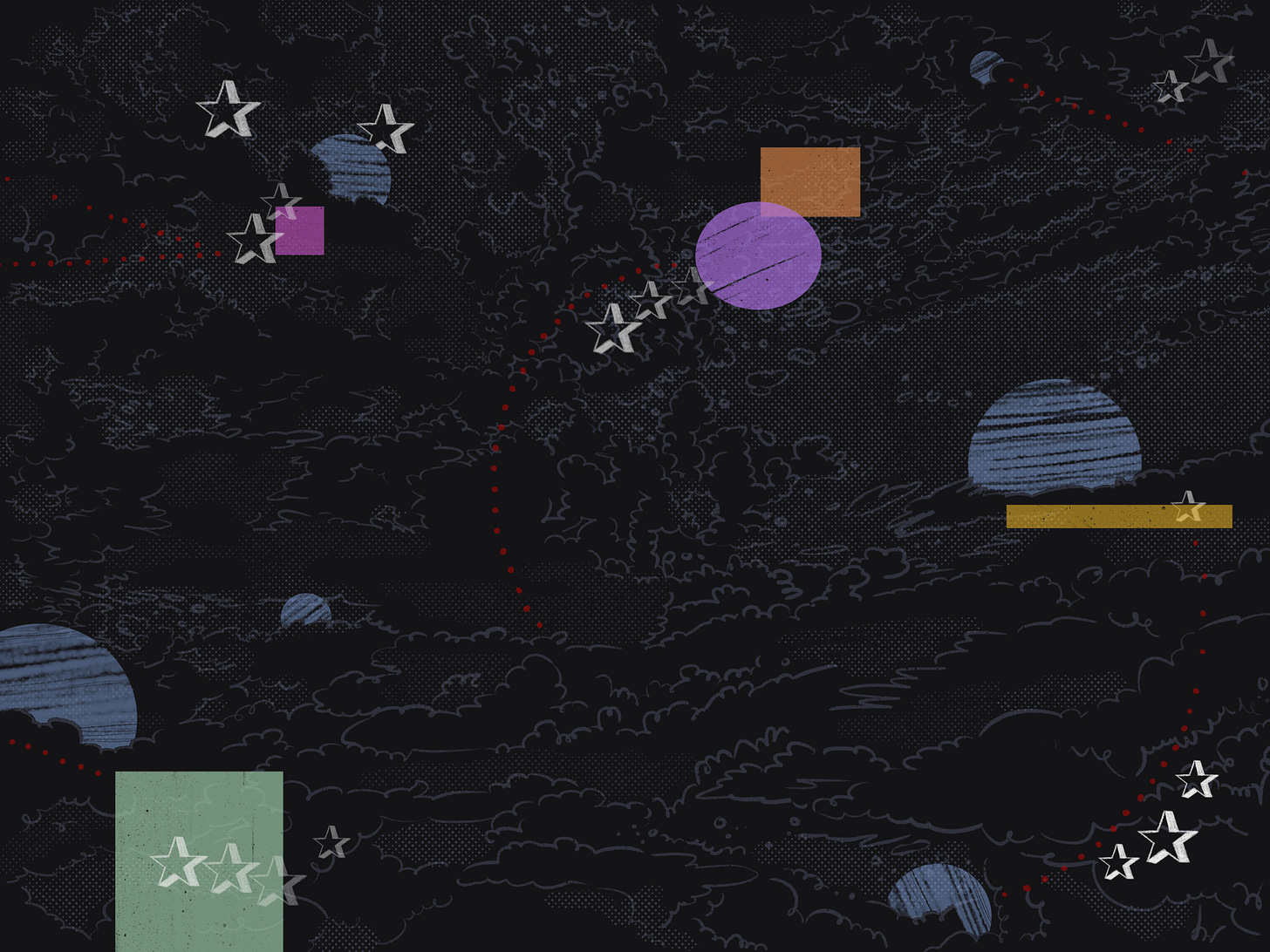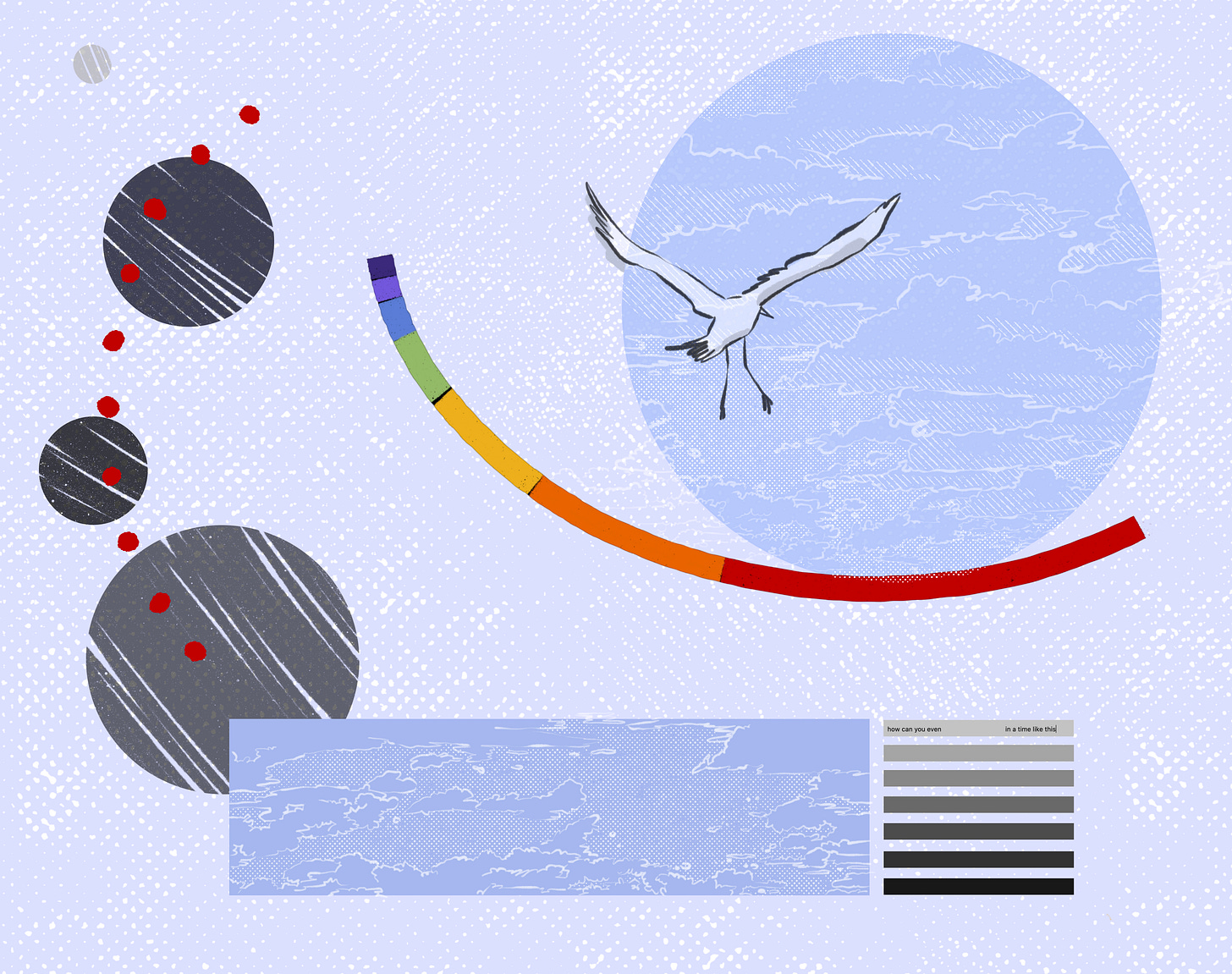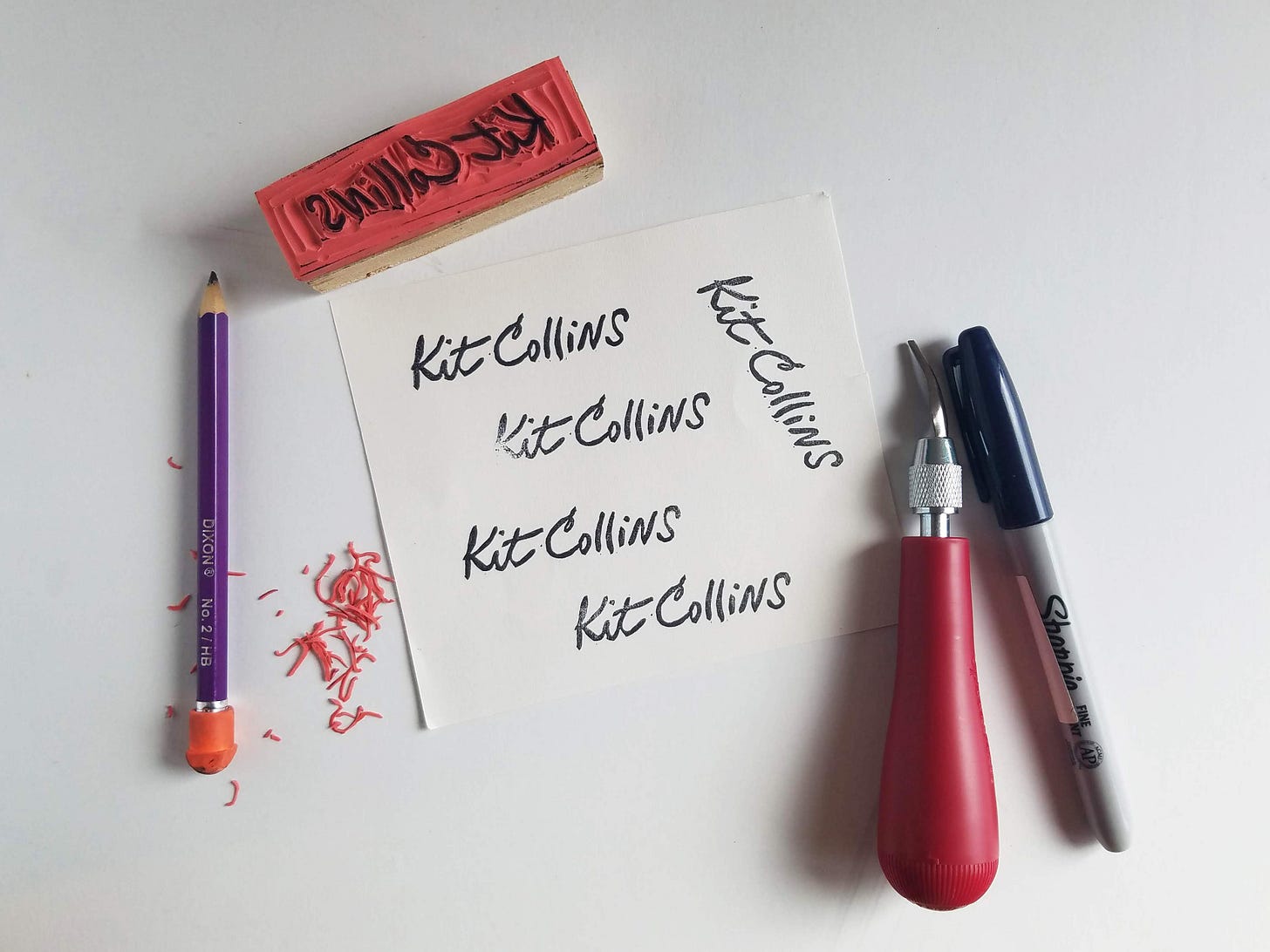Quick rant then it’s straight to clouds, stars, fun new prints
I have always had this trope in my brain of the indefatigable artist: their creative urge is just so strong, their cup just runneth so over, that they can’t not make art. Art is life!
I don’t think I’m alone in having this caricature in the sidecar. American culture really likes to put artists on a pedestal. Like most people, I have heard a lot of different variations of “wow, your minds just work differently!” That’s not to mention how cavalier people are about portraying artists as neurodivergent, crazy, or doomed to unhappiness. This language is so mainstreamed, it just goes by without comment.
Personally, I have always found this romanticization really annoying – artists are just people and people are artists. But it’s harmful, too. Cheerfully referring to artist types like they’re a different species makes “non-artists” feel like it’s some kind of chronic condition they missed the gene for. That’s sad! The magic of making art doesn’t come from hereditary quirkiness or a predestined connection to some creative divine. The magic is in doing a thing and getting something out of it – either you or somebody else, ideally both.
And while many people’s creative work is born of or inspired by ineffable or even mystical experiences, it’s not in anyone’s best interests that we let that trope monopolize our conception of what artists do. It’s an othering fiction for many people, and it’s intimidating. Even the most transcendent things in life are not transcendent all the time. Loving making art, and sometimes finding it banal and boring, are totally compatible. Sometimes I’m happy as a clam when I’m drawing or painting. Other times, I’m bored out of my gourd. It’s just like the rest of life.
So what’s my problem? I manage many pet peeves already and this fawning way we talk about artists is not particularly new. My beef is that this attitude helps us tokenize and atomize artists. Romanticizing the artist experience helps us romanticize artists’ struggles. It lets us get away with bad, milquetoast, box-checking approaches to that thing all communities love to talk about doing, “supporting artists.”
Have we all heard of greenwashing and pinkwashing? I think I’m seeing art-washing gaining traction. At least in greater Boston, the region with which I am most familiar, real estate developers and luxury property owners seem to be noticing that it looks very good indeed for them to be “supportive of the arts.” That appears to mean creating one or two high-profile mural or sculpture interventions per development. When I see these RFPs, I do not often see evidence of companies that are genuinely interested in purchasing an artwork. I think many of these clients are more interested in purchasing the ability to tout that they hired an artist, the ability to bill themselves as arty places for arty people. It’s branding.
The question of what our communities really need to do, if we are to exist in diverse, art-filled communities, is certainly a hard one. We shouldn’t pretend that individual projects are an answer to that question, but certain forces would prefer that we do. Creating marginally more opportunities for individual artists is fantastic news for the individuals who are awarded contracts or residencies; it does next to nothing for artists writ large, nor for “the arts.” 5 more RFPs per capita does not make a difference in whether your community is hospitable to the creative class overall. We should absolutely keep encouraging that more art be folded into public and development projects, while at the same time knowing that this is towards a different objective than meaningfully supporting artists. The big walls in our cities will get more interesting and wonderful, and meanwhile, bit by bit, the artists and all the other non-rich people who used to live there will keep getting gentrified out of the metro area.
When we romanticize artists, the implication is that these people are so pure in their love of creating that they will endure any conditions so long as they get to be creators. That’s so insulting – and exclusive. When I look around at the people in my network, I see a fair number of people who seem to have internalized this. I certainly did, for a while. Yes, I’m constantly working and stressed, but that’s just the price of getting to call yourself an artist!
Like so many other forces, this mindset puts the struggle and the blame onto individuals. It falsely separates our struggles from those of every other below-median earner or working-class household. You can’t afford to live here anymore and you don’t have health insurance? Well, it’s called being artist. Channel that into your work!
Artist opportunities are wonderful and indispensable for beautification, and indeed for individual artists for a short time. What they are not is a strategy for building communities in which the arts and artists can actually flourish. If we want arty communities, we need to create the conditions where the freelancers, the experimenters, the teachers, the working class and the capitalism defectors can actually survive. We need arts programming in public schools, non-employment-based health insurance, and workforce housing. It’s not magical, it’s not romantic, and we can’t mural our way there.
To be clear: It’s not bad that this new-ish surge of gigs is here, it’s good – it’s work! (I applied for and accepted one such gig recently, though the compensation was laughable given the complexity of the design requested and the value of the brand-new luxury condo building I’ll be making a painting for.) It’s just that we humans are too good at box-checking. All too easily we will authorize a mural wall or pass a Percent for the Arts Ordinance or establish a holiday art market and feel assured that this is meaningful progress. Meanwhile, the real estate developers and powers that be will encourage these alternative outlets, get credit when they hand out a contract or waive a tabling fee, rake in profits and raise the rent.
Between being a working artist with many working artist friends and my elected role in Medford, this kind of topic is always near the forefront of my mind. There’s never just one solution to a problem or issue, but there are some keystone ingredients. Expanding artist opportunities can be a beautiful and enriching part of the solution, but without making our communities affordable, we’re just solving for branding, not for people. A cake with less vanilla will be less delicious, but a cake that’s just vanilla isn’t a cake at all.
For the past couple of months, my comrades-in-arms and I on the City Council have been put on blast nearly every single week for bringing up about things like an Affordable Housing Trust funding, rent stabilization, and tenant protections; soon, I expect, upzoning (adding housing density) will be added to that list of sins. It’s taxing. It’s hard to do the stuff we need to do.
It is so not arty, so unglamorous – not fun at all. But we need it. I feel lucky to have drawing or painting or reading or writing or my various benign vices to retire to at the end of a long night of being yelled and/or glared at. And when time in the studio hits just right – maybe when one of those ineffable moments visits – it’s extra sweet.
Anyway, I was planning to talk about drawing
Let’s return to the realm of the normals, shall we? Lately, I’ve been embracing my love of skyward illustration themes. I recently finished two new drawings that indulge this favorite motif.
I call this one Men at Work, because Men at Work was my constant companion when I was working on it. (I really love new wave.)
I also recently finished this illustration which I’m grandly calling How can you even think of taking flight in a time like this:
Historically, I have struggled to enjoy, relax, or just exist comfortably, knowing that other people around the world are denied the ability to enjoy, relax, and just exist. In my life, this tendency has often been an accelerant for self-destructive or self-unhelpful behaviors. As I age, I’m grow increasingly accepting of the notion that self-abnegation can be very effective at keeping us preoccupied and busy, but isn’t actually helpful to other people; and at the same time, definitely unrelated, I think I’m getting more fun to be around. Maybe encouraging/embodying joy and fun, in spite of everything, even in a time like this, is an asset I can bring to other people and projects. Anyway: I made this drawing thinking about that.
Donating print profits
While drawing is celebration enough, to celebrate the sharing of new works, I’ve updated my old, neglected Etsy storefront. Goodbye, doggie stickers and postcards: it’s exclusively my favorite pop art illustrations and downloadable coloring sheets now. (And one remaining sticker sheet because I have too many of them.)
For the next month, I’ll be donating all of my profits from my Etsy store to the Middle East Children’s Alliance, which I have been supporting at the recommendation of some trusted friends. Please consider this a sign to bring a cloudy new print into your life.
You’re welcome
It is my custom to include a shitty recipe of my own design at the bottom of these newsletters, but this time I’ll leave you with a bona fide great recipe for Sephardic spinach pie that I have made for every single Passover seder since I came across it. I get so many compliments on this, it’s bananas. Bookmark it – it’s good all year round.
What else?
So much, but that’s enough for now. I’ll share some juicy updates about my mural series in Lowell and Brookline, and all my cool collaborators in those places, in another update soon.
Thanks for reading!
If you enjoy this newsletter, please consider forwarding to a friend, or supporting me with a paid subscription.







Beautifully written, and interesting ideas. Thank you.